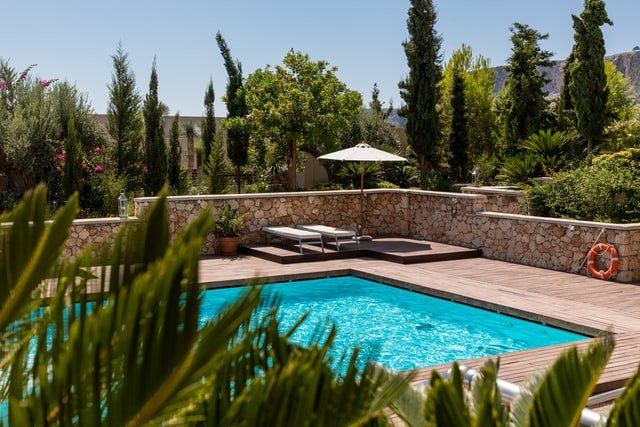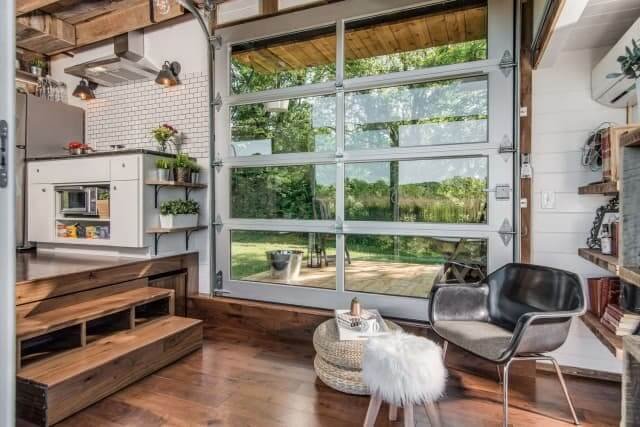by Guest Blogger: ISN
Owning a swimming pool is a popular childhood dream, but there’s more to these aquatic home additions than meets the eye. Maybe it’s common sense that pools require regular chemical and physical maintenance, but have you considered what owning a pool will do to the overall value of your home or the cost of additional insurance coverage? We’ll go over these lesser-known factors and touch on the more obvious ones so you have all the information you need before deciding as a homeowner or potential home buyer.
Buying a Home: Pool Included or Build Your Own?
If you’re on track to buying your own home and have your heart set on a pool, it makes sense to buy a home with one already installed, right? It’s true that installing one yourself can set you back $20,000-$60,000 for an in-ground and up to $8,000 for an above-ground unit, but a pool that comes with a home might not be the right option for you.
Take Repairs into Consideration
One of the significant cost contributors to owning a swimming pool is repair-related. In the best-case scenario, the previous owners were on top of chemical monitoring and minor repairs, so you can pick up where they left off at the usual upkeep cost when they hand you the reins. Unfortunately, it doesn’t take much to neglect pool maintenance, and you could be looking at a hefty bill of repairs for a unit you didn’t get to customize.
Chlorine imbalance can quickly eat away at your pool’s material. Tears in pool liners can lead to algae growth and the possibility of needing to replace the entire thing. Shoddy maintenance over the years can result in filter and pump system malfunction, causing the need to hire a costly technician to fix it.
More than One Option
Feeling discouraged? Don’t despair. You would think that a home with a pool already installed would cost more, but they generally cost the same, so you won’t have to adjust your price range to buy a house and opt to install your own unit. The benefits of installing your own are endless, starting with the ability to completely customize the pool itself, the location, the addition of a pool deck or surrounding landscaping. It’s definitely worth mentioning that you’ll end up with a brand new pool with no repair history to sneak up on you leaving total control in your capable hands.
What Can Your Pool Do For You?
Backyard swimming pools provide easily accessible fun throughout the summer months. Pools are a great way to cool off and relax. The addition of Cool Pool deck coating has a special cool-to-the-touch formula that helps keep pool decks cooler on hot days. If you have the option to heat or own an indoor pool, the enjoyment can extend year-round.
A World of Good
Aside from personal use for relaxation, exercise, and family quality time, a private water oasis is a fantastic centerpiece for celebratory gatherings. Poolside barbecues are a summertime staple for all ages, especially if you have kids. You’ll be the best host if you throw an end-of-school or end-of-summer pool party. With the money you can save on a venue, it’d be a piece of cake.
Of course, summer fun is high up on the pros list, but there are fundamental pool benefits. For adults, exercising in water is a full-body workout that is easy on the joints. Water activities are inherently relaxing, and limited sun exposure increases serotonin naturally.
For kids, having access to a pool can significantly decrease child mortality. It is a sad truth that drowning is the number one cause of loss of life for children between the ages of 1 and 4 and the number two cause up to age 14. Learning water safety and swimming regularly lowers this risk by 88%.
On the lighter side, a backyard pool provides other benefits like opportunities for socialization, outdoor entertainment, and quality time with friends and family. Research supports swimming’s contribution to sensory-motor development in children of all ages, especially those with special needs who have trouble participating in other activities.
What Can Your Pool Do For Your Home?
While it is true that generally, pools don’t add value to your home and may even decrease it, that doesn’t mean that you can’t be the exception to this rule. Many years ago, those who installed their pools didn’t have the power of the internet, and this handy cheat sheet to guide them towards the features that will add value to your home. Alternatively, several factors can (negatively) impact you and the price you pay for installing your pool.
Decked Out
On its own, a deck addition is one of the best home improvements you can make to drive up the cost of your home. Most renovations only recoup a 50-80% return on the investment — which means for every dollar you spend, you will only add 50-80 cents to your home appraisal. Installing a deck is one of the few renovations that return dollar-for-dollar on the investment. With that in mind, it makes sense to add a deck so you can increase your overall pool value. You can also rest easy knowing that you won’t lose anything down the line if you spring for pricier materials — all of the enjoyment, none of the risk.
Safety First
Although it’s not directly considered the value of your home, the cost of your home insurance impacts your wallet and will be affected by a pool, so there are a few things you need to know. Insurance providers consider residential pools an “attractive nuisance,” and homeowners are liable for anyone who uses their swimming pool, with or without permission. Should any lawsuits be filed against you, purchasing an umbrella policy to increase your liability coverage will serve as the safety net you may need.
Insurance rates are also affected by the levels of pool safety. Installing a fence around your pool will create a barrier to prevent accidents, but it can also lower the cost of your insurance and possibly bail you out if you get sued. On the other hand, installing a diving board can raise your insurance rates due to being considered an injury magnet.
Since your pool is on your own property, you don’t have a set of safety regulations to follow like a public or club pool is required to meet. These are things like signage that warn about the dangers of diving into shallow water or swimming unsupervised. These warnings are meant to draw attention and aren’t particularly attractive. Still, there are decorative ways to ensure safety if you frequently have guests over to swim or allow your older children to invite friends over while you promise to be cool and stay inside. Gentle reminders to keep glassware away from the pool or that the deck is “slippery when wet” may serve you well in the long run.
Pool lighting also provides safety—illuminating the pool’s edge and guiding the way back into the house. There’s no reason you can’t get creative with colored lights — it’s your pool, after all.
Damage
Over time, some damage is inevitable and usually minor. One of the most common pool repairs is a tear in the pool’s liner (we’ll get into what types of pool material has this problem soon), which causes a slow leak and loss of water in the pool. This can cost an average of $350 to fix and $2,200 if the tear is substantial and needs replacing entirely.
Other pool materials may crack due to drying out or soil movement. Many of these are superficial and need repair for aesthetic reasons, but significant soil movement can lead to foundation damage that needs immediate attention and repair. You’ll know if the cracks you see fall into this category if you’re experiencing water loss that cannot be attributed to evaporation or if rust is emerging from said cracks. Rust is a sure sign that water is reaching the rebar or pipe that provides structural support to your pool.
Hardware and Equipment
Like many things, multiple components work together to make your pool a safe and functional entertainment area. If some parts aren’t up to par, other mechanisms may need to compensate and decline faster. During your pool planning, you’ll need to decide what lights to put up, where to put steps in and out of the pool, and if you want or need ladders.
Another factor to consider is pool cleaning. Some owners rely on a weekly pool service or take on the duty themselves of skimming the leaves out of the pool and scrubbing the debris off the walls, but you can also opt to purchase a skimming machine that takes care of that for you. Several pool cleaning tips save you time, such as using a tennis ball to absorb oils that may get into the water from sunscreen and using baking soda as a chemically safe way to brighten pool tiles.
An essential part of pool maintenance involves drain cleaning, so it is crucial to think about the ability to access and service them. If you are buying a home with a pool, make sure your inspector goes over these items and possible repairs or upgrades you need to make. In either case, it’s probably best if an inspector helps you with more complex features involved in pool ventilation, such as filters, pumps, and timers. You will need to know what to look for to maintain minor upkeep yourself and then know when it’s time to contact a professional.
Pools also use plumbing, electrical components, and possibly pool heaters. It’s not expected that you become an expert on these elements, but awareness and some common sense will carry you a long way, as well as routine maintenance appointments with your chosen pool service.
Building a Pool? Don’t Skip These Steps
If you want your pool to last and save money in the end, you cannot scrimp on your pool’s initial and crucial building blocks. If you do these things right, you will have a quality home addition and fewer headaches in the future.
Location Matters
Before you embark on your pool building project, you must consult your municipality guidelines to determine where you can put your pool. The size of your backyard will contribute to pool size. Still, there will also be limitations based on the ability of machines to access the area, whether your property has a distance requirement from the fenceline or other buildings, and what other elements you want, such as a pool deck or landscape maintenance.
Is Soil Important
Building a pool starts from the bottom up. A foundation is crucial but what that foundation rests on is even more so. If you live in an area with a sandy soil type, your pool will need reinforcements to support the structure, which can add cost. If you have dense, compacted ground, you may require additional machinery to excavate, which is not included in a typical pool installation price. Many pool contractors offer low-cost or free estimates, and they can help you determine the best way to install your dream pool.
Laying the Foundation
The last significant step is laying the foundation of your inground pool. This will involve metal framing followed by a poured or formed substrate that takes the final shape of your pool. Depending on your budget and format, the final decorative layer can be applied, and you’re on your way to filling up.
Will it Pool?
If you are installing and designing a pool from scratch, the sky’s the limit — or your budget is. Even though your pool design can have endless shapes and customizations, these all fall into a few categories in the biz. The top three types of pools are either rectangle, freeform, or the well-known “kidney” shape. Of course, you can also have a circle pool, especially if you are looking at an above-ground option and any extended version of such.
The above terms usually apply to the shape of the pool as it appears from the surface, so there’s another group of words for what is happening below the surface. A drop-in pool features steps that lead you into the shallow end and a gradual slope to the pool’s deep end. Infinity pools require the support of certain terrain features but are characterized by one or more edges with water flowing over them, creating the illusion that the pool extends into the distance. There is also a plunge pool, larger than a spa but smaller than a standard swimming pool, so it’s perfect if you have limited yard space. Pool contractors even offer lap pools so you can train like an Olympian in your own backyard.
What Pools are Made Of
The top three materials are vinyl, fiberglass, and concrete. This refers to the outer material you and water will come into contact with. They are listed in order from least to most durable and least to most expensive. Pools with vinyl liners have the lowest price, but they need to be replaced every 5-9 years, so the expense adds up.
Fiberglass pools are incredibly durable and have a smooth gel-coat finish that is non-porous, so it requires fewer chemicals to care for. It also harbors significantly fewer bacteria. The downside of fiberglass lies in the installation. Because they are pre-formed in a factory, they are installed in one big piece. You will have to be able to accommodate a massive truck delivery and a crane to lower it into the ground. Both vinyl and fiberglass are flexible, so they are optimal in cold weather areas where freezing occurs, and elasticity is necessary to prevent cracks.
Concrete is the most popular pool material because it is entirely customizable and high in durability. Despite the total cost of ownership and chemical maintenance being the highest of the three, most pools installed today are this type due to the feasibility of installation. If you have the space to install one, you can accommodate the pool construction of a concrete unit.
It may seem like a lot at first, but there wouldn’t be 10.4 million residential swimming pools in the United States if it were impossible to keep up with care and maintenance. Once you get into the groove of pool ownership, it’ll feel like second nature and a small price to pay for your backyard paradise.




































